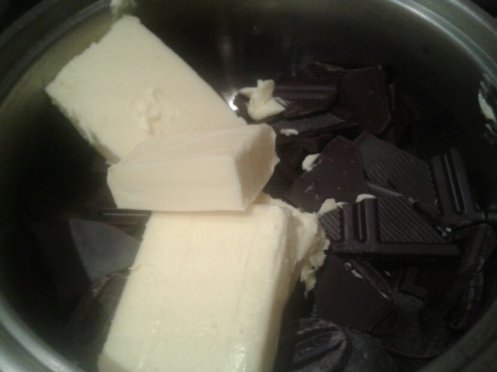
Hi there. It’s been a while, I know. Since I last posted here I have changed jobs twice, and I now have quite a long commute and a lot less time for blogging. I have also become a bit lazy and keep forgetting to take pictures as I cook. I have missed my blog though, and I am ready to revive it and start posting again ; probably not every week but hopefully regularly enough.
So here goes : the return of the Greedy Frog!
I was cooking a bit of a special lunch for our family last weekend . When planning the menu I decided on a Carbonnade à la Flamande (aka Belgian Ale and Beef stew) because it is delicious and can be made ahead and then just reheated in the oven (Nigella’s recipe in case you were wondering). This solved one problem, namely how to serve a slow-cooked casserole for lunch without needing to get up at dawn to prepare it. It however created another problem: the carbonnade left no room in the oven for a baked dessert. This is an issue for me because baked desserts are by far my favourites, both to eat and to make so I haven’t got many recipes for no – bake options.
I also have an irrational aversion for fridge cheesecakes (it is a cheeseCAKE for crying out loud, it needs to be baked!!!) so this was really not an option.
As I was leafing through cookbooks looking for inspiration, I remembered one of my Mum’s dinner-party staples from when I was a kid: the fabulous Orange Charlotte (yes I did grow up in the 80’s). It always looked stunning and drew a lot of oohs and aahs from the guests; and it tastes pretty good too. I remember thinking at the time that it was a rather decadent and terribly sophisticated dessert; nowadays I am not quite so awed by it anymore, but I still think it is rather special and a lovely centrepiece.
A word of warning: Us French people usually like to sneak quite a bit of alcohol in most recipes, and this one is no exception. Just remember that this Charlotte is not cooked (apart from the custard) so if you are catering for children or teetotallers make sure you omit the booze. Or put it in and just send the kids to bed early, your choice.
You will need (for an 18 cm Ø Charlotte mould):
3 oranges
500 ml milk
250 ml double cream
6 egg yolks (freeze the whites to make meringues another day)
220 g caster sugar
7 tbsp orange liqueur (optional, see intro. You can replace it with orange syrup)
1 tbsp. cognac (optional)
8 gelatine leaves (or enough to set 1 litre of liquids, check the packet instructions)
24/30 sponge fingers
Method:
Line the charlotte mould with cling film (if you can’t get hold of a charlotte mould, find a deep bowl or cake tin of the correct diameter with sides roughly the same height as your sponge fingers; a pudding basin works well too). Put your gelatine leaves to soak in a bowl of cold water.
Make the custard: Pour the milk into a large saucepan and grate the zest of 1 orange into it (reserve the orange to make the syrup). Bring to the boil then leave to cool a little. In a large heatproof bowl, whisk the egg yolks and 150 g of the sugar until pale. Add the milk gradually, whisking briskly (the milk should be warm rather than hot to avoid curdling the egg yolks). Pour the mix back into the saucepan and set on a low heat to thicken. This should take about 20 min, but make sure you stir constantly to stop it catching, and keep the heat low or the eggs will scramble. Patience is key here! When the custard coats the back of the spoon, take it off the heat. Drain the gelatine then add it to the custard, along with 2 tbsp. orange liqueur if using. Leave to cool.

Meanwhile, make the syrup: Squeeze the juice of the reserved orange into a measuring jug; make it up to 200 ml with water, add 1 tbsp. sugar, and transfer to a small pan with the squeezed-out halves and simmer on a low heat until reduced and syrupy. Drain into a jug, pressing the skins well to get as much flavour into the syrup as possible.
In a large bowl, whisk the double cream to a stiff Chantilly. Add the cooled custard gradually, mixing delicately to avoid knocking the air out of the Chantilly.
In a shallow bowl, pour the orange syrup and add 3 tbsp. orange liqueur (if using). Quickly dip the sponge fingers into the syrup on both sides, and line the bottom and sides of the mould. Fill the mould with the custard / Chantilly mix almost to the top, and finish with another layer of sponge fingers dipped in syrup (you can break off bits of the sponge fingers to fill in any gaps).

Refrigerate for at least 6 hrs or ideally overnight.
To decorate, peel the leftover oranges, separate into segments and remove all the peel and pith. If you have time, finely cut the peel and blanch it for a minute in boiling water with 2 tbsp of sugar mixed in. Drain.
To serve, simply invert the charlotte onto a serving plate, and arrange the orange segments around and on top of it, and the peel if using.











